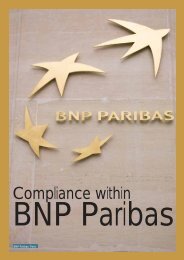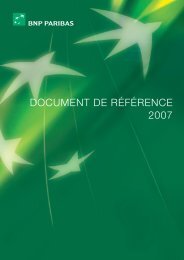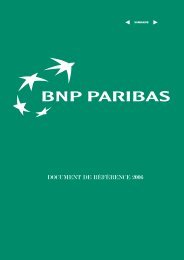2007 REGISTRATION DOCUMENT
2007 REGISTRATION DOCUMENT
2007 REGISTRATION DOCUMENT
- No tags were found...
Create successful ePaper yourself
Turn your PDF publications into a flip-book with our unique Google optimized e-Paper software.
5 NotesCONSOLIDATED FINANCIAL STATEMENTSto the financial s tatements p repared in accordance with I nternational Financial Reporting S tandards as adopted by the European Union< Contents >A similar quantitative and qualitative method is applied for unlistedvariable-income securities.In the case of fixed-income securities, impairment is assessed basedon the same criteria as applied to individually impaired loans andreceivables.Impairment losses taken against variable-income securities are recognisedas a component of net banking income on the line “Net gain/loss onavailable-for-sale financial assets”, and may not be reversed throughthe profit and loss account until the securities in question are sold. Anysubsequent decline in fair value constitutes an additional impairmentloss, recognised in the profit and loss account.Impairment losses taken against fixed-income securities are recognisedin “Cost of risk”, and may be reversed through the profit and loss accountin the event of an increase in fair value that relates objectively to anevent occurring after the last impairment was recognised.1.c.6Issues o f d ebt s ecuritiesFinancial instruments issued by the Group are qualified as debtinstruments if the Group company issuing the instruments has acontractual obligation to deliver cash or another financial asset to theholder of the instrument. The same applies if the Group may be obligedto exchange financial assets or financial liabilities with another entityunder conditions that are potentially unfavourable to the Group, or todeliver a variable number of the Group’s own equity instruments.Issues of debt securities are initially recognised at the issue valueincluding transaction costs, and are subsequently measured at amortisedcost using the effective interest method.Bonds redeemable for or convertible into equity instruments of the Groupare accounted for as hybrid instruments with a debt component and anequity component, determined on initial recognition.1.c.7Own e quity i nstruments and o wn e quityi nstrument d erivativesThe term “own equity instruments” refers to shares issued by the parentcompany (BNP Paribas SA) or by its fully-consolidated subsidiaries.Own equity instruments held by the Group, also known as treasuryshares, are deducted from consolidated shareholders’ equity irrespectiveof the purpose for which they are held. Gains and losses arising onsuch instruments are eliminated from the consolidated profit and lossaccount.When the Group acquires equity instruments issued by subsidiariesunder the exclusive control of BNP Paribas, the difference between theacquisition price and the share of net assets acquired is recorded inretained earnings attributable to BNP Paribas shareholders. Similarly, theliability corresponding to put options granted to minority shareholdersin such subsidiaries, and changes in the value of that liability, are offsetinitially against minority interests, with any surplus offset against retainedearnings attributable to BNP Paribas shareholders. Until these optionshave been exercised, the portion of net income attributable to minorityinterests is allocated to minority interests in the profit and loss account.A decrease in the Group’s interest in a fully consolidated subsidiaryis recognised in the Group’s accounts as a change in shareholders’equity.Own equity instrument derivatives are treated as follows, depending onthe method of settlement:■ as equity instruments if they are settled by physical delivery of a fixednumber of own equity instruments for a fixed amount of cash or otherfinancial asset. Such instruments are not revalued;■ as debt instruments if the contract includes an obligation, whethercontingent or not, for the issuer to repurchase its own shares;■ as derivatives if they are settled in cash, or if the issuer can choosewhether they are settled by physical delivery of the shares or in cash.Changes in value of such instruments are taken to the profit andloss account.1.c.8Derivative i nstruments and h edgea ccountingAll derivative instruments are recognised in the balance sheet on thetrade date at the transaction price, and are remeasured to fair value onthe balance sheet date.Derivatives held for trading purposesDerivatives held for trading purposes are recognised in the balance sheetin “Financial assets at fair value through profit or loss” when their fairvalue is positive, and in “Financial liabilities at fair value through profit orloss” when their fair value is negative. Realised and unrealised gains andlosses are taken to the profit and loss account on the line “Net gain/losson financial instruments at fair value through profit or loss”.Derivatives and hedge accountingDerivatives contracted as part of a hedging relationship are designatedaccording to the purpose of the hedge.Fair value hedges are used in particular to hedge interest rate risk onfixed-rate assets and liabilities, both for identified financial instruments(securities, debt issues, loans, borrowings) and for portfolios of financialinstruments (in particular, demand deposits and fixed-rate loans).Cash flow hedges are used in particular to hedge interest rate riskon floating-rate assets and liabilities, including rollovers, and foreignexchange risk on highly probable forecast foreign currency revenues.At the inception of the hedge, the Group prepares formal documentationof the hedging relationship identifying the instrument (or portion of theinstrument or portion of risk) that is being hedged; the hedging strategyand the type of risk covered; the hedging instrument; and the methodsused to assess the effectiveness of the hedging relationship.On inception and at least quarterly, the Group assesses, consistentlywith the original documentation, the actual (retrospective) and expected(prospective) effectiveness of the hedging relationship. Retrospectiveeffectiveness tests are designed to assess whether actual changes in thefair value or cash flows of the hedging instrument and the hedged itemare within a range of 80% to 125%. Prospective effectiveness tests aredesigned to ensure that expected changes in the fair value or cash flowsof the derivative over the residual life of the hedge adequately offsetthose of the hedged item. For highly probable forecast transactions,effectiveness is assessed largely on the basis of historical data for similartransactions.1234567891011120<strong>2007</strong> Registration document - BNP PARIBAS
















